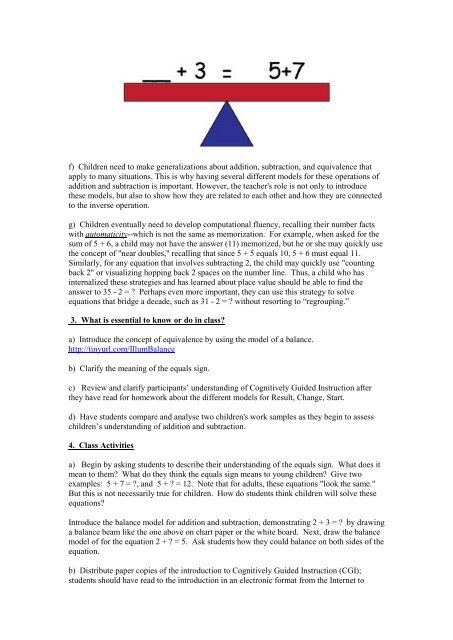Course Guide - USAID Teacher Education Project
Course Guide - USAID Teacher Education Project
Course Guide - USAID Teacher Education Project
Create successful ePaper yourself
Turn your PDF publications into a flip-book with our unique Google optimized e-Paper software.
f) Children need to make generalizations about addition, subtraction, and equivalence thatapply to many situations. This is why having several different models for these operations ofaddition and subtraction is important. However, the teacher's role is not only to introducethese models, but also to show how they are related to each other and how they are connectedto the inverse operation.g) Children eventually need to develop computational fluency, recalling their number factswith automaticity--which is not the same as memorization. For example, when asked for thesum of 5 + 6, a child may not have the answer (11) memorized, but he or she may quickly usethe concept of "near doubles," recalling that since 5 + 5 equals 10, 5 + 6 must equal 11.Similarly, for any equation that involves subtracting 2, the child may quickly use "countingback 2" or visualizing hopping back 2 spaces on the number line. Thus, a child who hasinternalized these strategies and has learned about place value should be able to find theanswer to 35 - 2 = ? Perhaps even more important, they can use this strategy to solveequations that bridge a decade, such as 31 - 2 = ? without resorting to “regrouping.”3. What is essential to know or do in class?a) Introduce the concept of equivalence by using the model of a balance.http://tinyurl.com/IllumBalanceb) Clarify the meaning of the equals sign.c) Review and clarify participants’ understanding of Cognitively <strong>Guide</strong>d Instruction afterthey have read for homework about the different models for Result, Change, Start.d) Have students compare and analyse two children's work samples as they begin to assesschildren’s understanding of addition and subtraction.4. Class Activitiesa) Begin by asking students to describe their understanding of the equals sign. What does itmean to them? What do they think the equals sign means to young children? Give twoexamples: 5 + 7 = ?, and 5 + ? = 12. Note that for adults, these equations "look the same."But this is not necessarily true for children. How do students think children will solve theseequations?Introduce the balance model for addition and subtraction, demonstrating 2 + 3 = ? by drawinga balance beam like the one above on chart paper or the white board. Next, draw the balancemodel of for the equation 2 + ? = 5. Ask students how they could balance on both sides of theequation.b) Distribute paper copies of the introduction to Cognitively <strong>Guide</strong>d Instruction (CGI);students should have read to the introduction in an electronic format from the Internet to
















